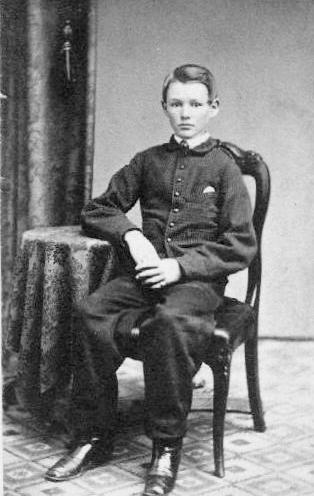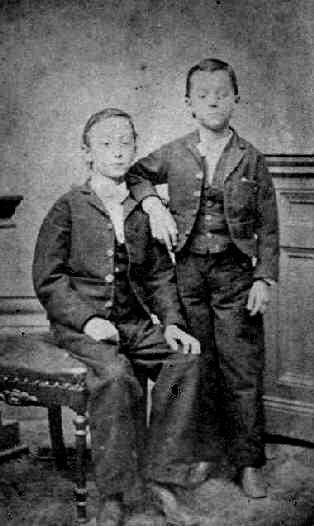The 1820s
We also see boys wearing long pants with tunics. Trends are difficult to follow in the early 19th century before photograph was developed. Gradually as the 19th century progressed, long pants became standard for both boys and men. The suit also became the sandard male outfit.
The 1840s
The Daguerreotype appeared in the 1840s and we begin to more images of boys. Most of the imasges show boys once breeched wearing long pants. This is clealy observeable when photography began to produce substantial numbers of images for the first time (1840s). <>br>
The 1850s
Long pants continued to be standard for boys until the mid-19th century when some younger boys began wearing types of shortened-length pants, both bloomer knickers and knee pants. We use the term knee pants, but at first they were worn well below the knee, commonly at calf level.
|
The 1860s
The development of the albumen process and the CDV sharply increased the number of photographic images. As a result, we have archived large number of portaits from the 1860s. We mostly see suits that had jackets matching the trousers in the 1860s. Younger boys might wear one pirce or blouse suits with long pants. This included very young boys. The age of breaching varird consierably from family to family. Some boy weere nreeched quite yoing motly eiyh long pants. Most boys in the 1860s wore long pants. This was especially true in rural areas which were less affected by fashion trends. We see some younger boys wearing shortened-length pants. Many boys began wearing long pants as soon as they were breeched. Some younger boys wore shortened-length pants, but this was not yet stndard. We do not see many boys over age 8 years wearing these shortened-length pants in the 60s. And they wre not as common as long pants. The Lincoln boys, for example, only wore long pants. This was not the case for the more fashionably dressed Davis boys. Most of the boys wearing shortened-length pants wore them with cut-away jackets, but even for younger boys, long pants were the most common with cut-away jackers. We even see boys with ringlet curls wearing long pants. A good examle is an unidentified New York boy. Collar buttoning and lapel sack suit jackets were almost always worn with long pants. We mostly see school-age boys wearing long pants, alythough school photograpy was just beginning.
|
The 1870s
Through the 1870s, long pants suits were the nost common. Thegreat proprtion of the 1870s portraits show boys wearing long pasnts sits. Gradually we see shortenened-length pants beginning to increase in popularity for younger boys, especially by the end of the decade. Even so, we mostly see boys wearing long pants suits in the 1870s. About age 8 years was the cut off for shortened-length pants and we do not see boys older than 10 years wearing them. And there were significant demographic trends. Almost all boys in rural areas wore long pants suits. The shortened-length pants were mostly seen with fashionable families in the cities, especially the big cities. The cut-away jacket suits begin declining in poularity and the military style collar buttoning suits are no longer seen. Three-piece suits with vests were common. While most boys continued wearing long pants, the shortened-length pants were nonlonger worn just with cut-away jackets. Quite a few family portraits show all the boys in long pants suits, often all lapel sack suits.
The 1880s
Knee pants increased in popularity during the 1880s, but long pants suits were the most common for American boys. Gradually knee pants became increasingly common, but even bybthe end of the decasde were still not very common for younger teenagers.
The 1890s
American boys mostly wore long pants in the 19th century. In fact it was boys who first began wearing long pants at the turn of the 19th century. By the 1890s this had changed. Shortened-length pants appeared at mid-century, mostly knee pants. But knee pants were mostly for younger boys. Only by the 1890s do we begin to see older boys wearing knee panrs, especially by the the ed of the decade. Knee pants were fairly standard for younger teens and by the end of the decade we also see older teens weearing knee pants. This varied from fasmily to family. The boys in some familes began wearing long pants earlier than in others. This was especially the case in rural areas. Social class was a factor here. It was also more prevalent in working-class families where children did not continue their education beyond primary schools which by the 1990s meant the 8th grade or about 12-13 years of age. Boys who left school and began working were more likely to wear long pants suits thasn boys still in school. We see a good bit of variation. Knee pants suits had become standard for American boys, but not universal.
HBC
Navigate the Boys' Historical Clothing Web Site:
[Return to the Main U.S. long pants suit chronology page]
[Return to the Main U.S. long pants suit page]
[Return to the Main U.S. suit pants page]
[Return to the Main U.S. long pants chronology page]
[Introduction]
[Activities]
[Biographies]
[Chronology]
[Clothing styles]
[Countries]
[Bibliographies]
[Contributions]
[FAQs]
[Glossary]
[Images]
[Links]
[Registration]
[Tools]
[Boys' Clothing Home]
Created: 11:45 PM 7/29/2009
Last updated: 5:57 AM 11/16/2022


 >
>